The Latin term “hematuria” is indicated by detection in the urine admixture of blood. Patients notice the appearance of reddish coloration of urine. The intensity of the color depends on the amount of blood.
In normal healthy human can detect not more than 2 red blood cells in field of view. In the urine collected for 12 hours, the number of cells should not exceed 105.
If laboratory revealed more, the symptom is regarded as a possible pathology, and the physician must identify the causes of hematuria.
To distinguish:
- the microhematuria, the presence of blood (RBCs) can be confirmed only by microscopic examination of sediment;
- gross hematuria – urine becomes similar to meat slops, and has a dark red color.
Microhematuria as a normal variant and improper collection of urine
Not always, the presence of microscopic hematuria indicates that the disease.
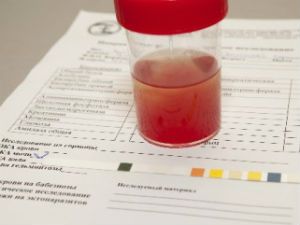
A small increase in urine red blood cell count is possible with the collection analysis:
- the abuse of alcohol, eating spicy and salty foods;
- visit the steam room or sauna;
- prolonged overheating in the sun;
- the worries.
Microhematuria may occur after walking or running for long distances in athletes. You know the same as the soldiers forced March, even has the title “March hematuria”. What it is, from the point of view of the mechanism of development remains unclear. A long observation of men with previously identified marches form indicates the absence of connection with any renal changes.
This symptom lasts a short time and quickly disappears on its own, if you pause exercise.
The preservation of red color of urine may indicate pathology. Patients sometimes mistaken for hematuria such color after the ingestion of foods with dyes, beets, carrots.
Re-analysis after the restrictions in the diet allows to reveal the truth
On the other hand, there are diseases in which microhematuria appears to work sporadically. An example is nephroptosis (omission kidneys), pathological mobility: the red blood cells get into the urine when the vertical position of the patient, disappear lying down. Gross hematuria does not happen in a healthy person. Most often it indicates kidney or urinary tract.
Mistaken for hematuria accept discharge from the genitals.
Women have it:
- prolonged menstruation;
- cervical erosion;
- uterine bleeding in fibroids;
- postpartum disorders.
Hematuria in men can be associated with exacerbation of prostatitis, benign prostatic hyperplasia.
As the blood into the urine?
In a healthy organism, not mixed blood and urine, there are physiological barriers:
- the structure of the vascular wall.
- the dense fibrous capsule of the kidney;
- membrane apparatus in the renal glomeruli;
- muscle and the epithelial layer in the urinary bladder and the ureters.
Causes of hematuria in the mechanism of development are divided into extrarenal and renal. Let us examine the details of each option.
Extrarenal hematuria
The mechanism of penetration of blood in the urine can be caused by:
- The destruction of the fibrous capsule of the kidney or urinary tract sheath with trauma, collapse of the tumor – bladder cancer is the most common cause of hematuria in older men and in young and middle – adenocarcinoma of the prostate.
- Urolithiasis is accompanied by a discharge of stones and their movement through the ureter.
- Massive inflammation with ulceration of the wall of the bladder – hematuria in women causes chronic cystitis, inflammation increases the permeability of the vascular wall, loosens the tissue like arteries and veins within the vascular bundle, the urinary organs (bacterial defeat, sistematis, tuberculosis, chlamydia).
- Mechanical compression of vessels of a growing tumor or an enlarged renal pelvis (hydronephrosis), which causes local stagnation and the increase of permeability is due to the differential pressure.
- Diseases blood clotting disorders (hemophilia), overdose of anticoagulants are the factor in the defeat of any organ, including the urinary system.
Especially hurt the walls of the ureters oxalate stones, having sharp edges

In diseases, accompanied by decompensation of heart manifested by hematuria as a sign of General stagnation in the venous network of the pelvis. Formed phlebitis, thrombosis in small veins, they increase the pressure inside of the vessel and move the red blood cells in the urine.
Renal hematuria
The mechanism of renal hematuria is associated with disruption of structural components:
- The destruction of the membrane of the nephron. It provides filtering of the urine and normally retains the red blood cells in the glomeruli. The process occurs when any form of inflammation of the parenchyma (pyelonephritis, glomerulonephritis). The basement membrane is affected as in non-infectious, and autoimmune inflammation.
- Toxic effect on tubules, interstitium toxic substances, medication overdose (Cyclophosphamide, Heparin, Warfarin) poisoning, hypersensitive, polycystic kidney.
- Enhanced intravascular clotting on the background of antiphospholipid and disseminated intravascular coagulation syndromes.
- Systemic diseases that occur with lesions of the capillary walls (hemorrhagic fever, diathesis, blood diseases). They cause local disruption of glomerular filtration, increase the permeability of the basal membrane.
Destruction of the glomerular apparatus is the basis of hematuria in diseases with a hereditary form of transmission.
These include:
- essential and HCV-associated mixed cryoglobulinemia;
- Fabry disease;
- IgA nephropathy;
- goodpasture’s syndrome.
The tissue necrosis with hematuria accompanies sickle cell anemia, renal vein thrombosis, kidney infarction, malignant hypertension.
According to another classification of the causes of hematuria are divided into:
- in prerenal – there was no connection with the renal pathology (infectious diseases, sepsis, food poisoning);
- renal or kidney – are necessarily related to the kidneys;
- postrenal – dependent destructive processes in the underlying ways the urinary tract (stone in the ureter, bladder tumor, anomalies, cystitis, urethritis).
These facts confirm the need to determine the cause of blood in the urine with the help of modern diagnostic methods.
What symptoms manifested hematuria?
Hematuria itself is not a disease, but a symptom. Her appearance is alarming the treating physician, as is often accompanied by exacerbation of the disease. This is especially true of gross hematuria.
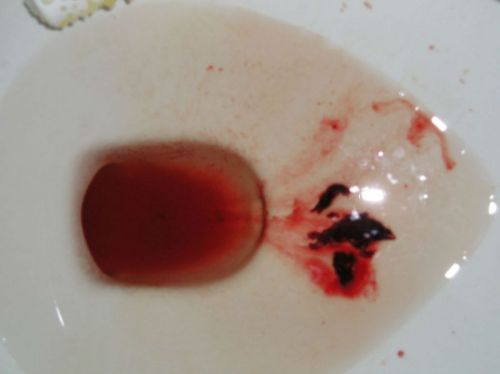
During massive bleeding from the kidney due to trauma, neoplasms, bladder cancer and adenocarcinoma of the prostate on a background of urination appears intensely colored urine with clots
Perhaps the overlap of the ureteral openings and the neck of the bladder with clots. Accumulated a significant amount of urine mixed with blood. Muscle pererastayut. The condition is called “tamponade of the bladder.”
Clinically by acute urinary retention:
- with pain over the bosom, radiating to the lumbar region, a side wall of the abdomen;
- constant urge to urinate;
- the leakage of urine;
- nausea;
- an increase in temperature.
Hematuria (often gross hematuria) is part of the nephrotic syndrome with hypertension, edema. The appearance of this combination indicates acute glomerulonephritis or chronic.
At the same time show signs of kidney failure:
- oligo – and anuria;
- the increase of creatinine in the blood;
- protein in the urine.
If renal hypertension causes congestive heart failure, appear:
- shortness of breath;
- swelling in the legs;
- cough;
- tachycardia.
Reduction of hematuria or disappearance of the evidence of the remission of the inflammatory process, the transition of chronic nephritis in remission. Metabolic disorders caused by a change in the function of tubular reabsorption (accumulation of calcium, urea), contribute to long-term microscopic hematuria.

End-stage renal failure occurs:
- with hematuria,
- anemia,
- diarrhea
- disorders of brain function (confusion, convulsions),
- ulcerative stomatitis,
- the secretions of urea on the skin.
Gross hematuria for bladder cancer combined with prolonged fever, pain
For urolithiasis characterized by acute cramping, pain, very intense, spread to the lower back, abdomen, groin, external genitals. Hematuria occurs after pain, accompanied by frequent urination.
Usually there is a link attack:
- with prolonged walking or jolting in transport;
- the use of alcohol.
Asymptomatic hematuria – complicates the task of diagnosis. When uncertain etiology bleeding in the urine or hematuria is intermittent, the patient needs to conduct a comprehensive examination to exclude diseases causing this manifestation.
Diagnosis
If gross hematuria visible to the eye, microhematuria can be detected only by microscopy of urine sediment.
The study of the structure of the cells indicates the level of possible lesions of the urinary tract:
- glomerulonephritis identified leached form red blood cells;
- at a lower level wall of the erythrocytes remains unchanged.
Using dvuhtonnoy sample practical the doctor can approximately determine the source of bleeding.
The patient needs to urinate in two containers without any interruption. In the first approximately 1/3 of urine produced, the second – the remaining 2/3.
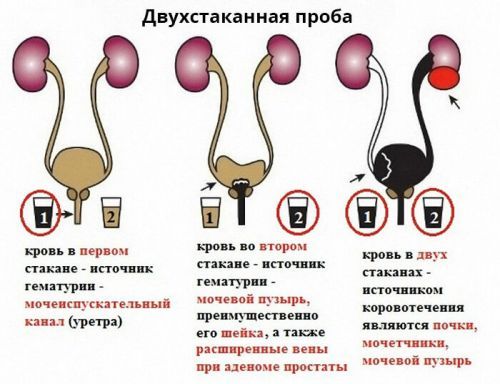
Decoding the sample divides portions:
- the primary hematuria it is called “initial” – is observed when the source of bleeding in a damaged urethra (to distinguish from urethrorrhea injuries, they are not associated with urination, occurs involuntarily);
- in the first vessel of hematuria is not, and in the second portion there – with the possible presence of lesions of the back of the urethra, bladder (cystitis, cancer), adenoma and carcinoma of the prostate, such hematuria is called “terminal”;
- the blood in both glasses – “total” hematuria indicates involvement of the renal pelvis, a ureter.
Total hematuria often defines a poor prognosis and method of treatment of the disease. It occurs when renal tuberculosis, ulcerative cystitis, papillary necrosis, urolithiasis.
The sample is applied, if it is not possible to quickly carry out other studies
The simultaneous presence of clots tells about the destruction of large vessel.
The shape of the blobs changed:
- have kidney or a ureteral – worm-like appearance;
- in the bladder – there is no typical shape, just “pieces”.
Laboratory hematuria confirmed by:
- special tests on the hemoglobin of red blood cells;
- microscopy of the urinary sediment;
- according to the method Nechiporenko count erythrocytes, leukocytes, and cylinders in 1 ml of urine, the number of red blood cells should not exceed 2 thousand cells.
With the purpose of differential diagnosis of hematuria and confirmation of renal origin is carried out:
- urine analysis (protein, cylinders, leukocytes, bacteria, salt crystals);
- biochemical blood tests (creatinine, electrolytes, alkaline phosphatase);
- immunological blood samples (to increase content of IgA, cryoglobulin, antinuclear antibodies).
Phase-contrast microscopy to distinguish glomerular (glomerular) hematuria from renal aglomerarea.
Method helps in the differential diagnosis:
- when glomerular – identify differences in shape and size more than 80% of erythrocytes (dysmorphism), their shells torn, uneven contours;
- when aglomerarea – on the contrary, more than 80% of the erythrocytic cells have the same size and form (isomorphism).
- possible combined form.
Use instrumental methods:
- cystoscopy;
- Ultrasound of the kidneys and abdomen, TRUS of the prostate in men;
- computed tomography and MRI of the abdomen and pelvis;
- excretory urography;
- biopsy samples is implemented a study of the kidney.
The attending physician survey of patient and primary tests appoints most recommended method of examination. For the solution of the question of the stage of disease and choice of treatment it is necessary to identify not only the source of the bleeding, but his one – or two-sided origin, the intensity, the degree of danger to the body.
Features of hematuria in children
When analysing the examination of the child, one should not forget that renal filtration in children from one year to two years has not reached optimal development. The glomerular membrane while transmits red blood cells. Normal allowed the identification of up to 5 cells per field of view.
A permanent record is established after the age of two:
- for girls up to 3 red blood cells;
- boys – 1.
The excess is regarded as hematuria. The physiological nature of the symptom is possible with insufficient adaptability of the children to the ambient conditions.

Hematuria in children possible:
- prolonged overheating in the sun or in the bath;
- feeding spicy and salty food, canned food;
- overload power oranges, chocolate;
- stressful situations;
- the use in the therapy of certain medications.
Hematuria, the child appears with increased physical activity (especially prolonged walking, running)
Parents can get erroneous result of analysis, if the child is correctly washed in the appearance of enterocolitis with diarrhea. Teenage girls do not always take into account the incomplete end of the period. Microhematuria possible when inflammation of the appendages, endocrine failures.
What causes hematuria in pregnant women?
Hematuria during pregnancy is triggered by the following reasons:
- diseases mentioned above, injuries of the kidneys;
- changed hormonal background;
- the growth of the fetus, compression of the bladder in the third trimester, which contributes to the formation of stones;
- increased possibility of infection of the urinary tract due to violations of the outflow of urine.
Pregnancy causes disruption remission and intensification of chronic diseases, such as anemia, systemic lupus erythematosus, diabetes mellitus, hemorrhagic diathesis. Observation and management of pregnancy in women with these diseases is carried out simultaneously by physicians midwives and specialists in the field.
Problems treatment
The treatment of hematuria is carried out after determining the cause and therapy of the underlying disease. If the “culprit” is an inflammatory process that required antibiotics, other means of combating bacteria, viruses, specific flora in the urine.
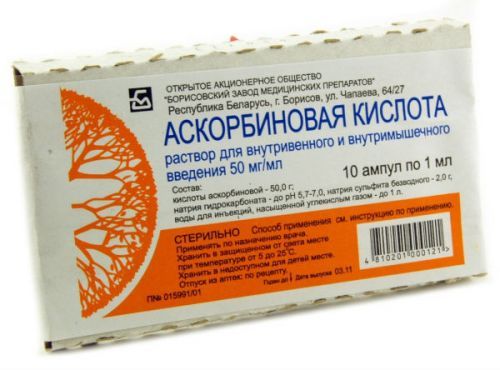
Autoimmune processes are treated with drugs that suppress the excessive reaction. Poisoning need to detoxification, if necessary, hemodialysis.
Neoplastic diseases, urolithiasis cannot be cured without chemotherapy and surgery. Disease capillaries blood require special preparations.
To strengthen the walls of blood vessels prescribed vitamin C, Rutin
If necessary, increase clotting with calcium chloride, Dicynone.
Folk remedies is also correct to treat the underlying disease, but herbalists strongly recommended for hematuria use decoctions of:
- juniper;
- bark of barberry;
- BlackBerry;
- St. John’s wort;
- elderberry flowers and cornflower;
- knotweed;
- the pods of beans.
Reasonable patients are not advised to self-treat without consulting a doctor. The problem of evaluation of hematuria associated with mistakes and late diagnosis of tumors. Therefore, early treatment of persistent and finding the causes are of such great significance.

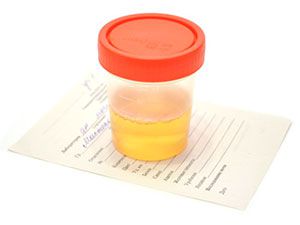

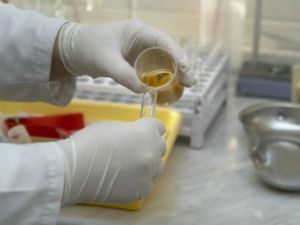
!That may be a slight bit generalizing. Could you add some more detail for me please? 🙂
News of politics in USA. We n we publish all of them fresh and global events USA, estimates experts. All evil in the world exists with the quiet tacit consent of the indifferent. No one provides us with incentives. We are Enthusiasts. We are building a civil society. The people are the bearer of sovereignty and the only source of power. No one can usurp power.
Patients sometimes mistaken for hematuria such color after the ingestion of foods with dyes, beets, carrots.
Hi there! Such a nice article, thank you!
So this post honestly made me think! TY-I hadn’t seen things this way otherwise.
this is some explanation you have there!
I got good info from your blog
Very good post! We are linking to this particularly great post on our site. Keep up the great writing.